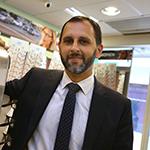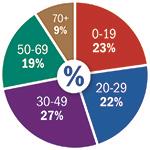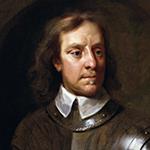Founded in 1209, Cambridge University is older than the Aztec civilisation. Since then it has produced some of the world’s greatest minds. Now, the university’s prestige attracts eager students and visitors from across the globe and has established the town as both a centre of learning and a vibrant place to live.
‘The ancient buildings, green spaces and river Cam all combine to make Cambridge a truly beautiful city,’ says Kam Dhillon, optometrist director at Specsavers. ‘There are festivals and events on all year round and the international students and tourists give the city a cosmopolitan feel which makes it a vibrant place to work.’
The practice has five consulting rooms, OCT, a visual field analyser and an FDT. Dhillon says: ‘The OCT is proving popular with our patients with a significant proportion deciding to have scans taken as part of their eye examination. It has greatly enhanced the quality of care we are able to offer our patients.’

‘We employ a lot of optometry and dispensing students, many of whom stay on with us after qualifying,’ says Dhillon (pictured). ‘Our retail and professional teams now have a very international feel, with members from all over Europe and even from Canada.’
David Arnott is practice manager and dispensing contact lens optician at Clamp Opticians, which has three testing rooms, as well as OCT facilities. ‘We’re a very busy, top-end practice and we stock niche products rather than the mainstream frames you find elsewhere.’
‘We see a diverse group,’ says Arnott. ‘We don’t have many children coming into store, but we do get a lot of both young and old professionals. Also, lots of academics come to us who are quite particular about what they want.’
Russ Lawson, store manager at David Clulow Opticians, says his practice is ‘situated in between three colleges so we have lots of students come to us, as well as having lots of older people and academics’. The practice also employs a number of optometry and dispensing optician students from the local universities.
A ‘fashion-focused’ outlet, David Clulow has been in town for 21 years, with Lawson working there for the past five. He says that metal frames have had a resurgence in recent times, with companies like Lindberg selling well because of its lightweight titanium frames. Oliver Peoples has also been popular due to its hand-crafted designs, vintage style and reasonable price. Lawson says people even come from Wales to access its designer frames.
Who’s in town
Total: 12
Independents: 5
Multiples: 7
Average costs
The price of an eye exam in Cambridge ranges from £10 to £115, at an average of £40.
Population

188,875
Community eye care
According to the Locsu Atlas Map of Optical Variation, Cambridgeshire Local Optical Committee has a contract with Cambridgeshire and Peter-borough CCG and Foundation Trust in Cataract Post-op, Cataract Referral, Glaucoma Referral Refinement, OHT Monitoring and Minor Eye Conditions Service.
Health and affluence
- The average house price in Cambridge is £472,260 compared with a UK average of £223,257 (Land Registry, 2017).
- Cambridge has an average salary of £30,811 compared with the national average of £27,271 (Payscale, 2018).
- By 2030, an estimated 29,990 people in Cambridgeshire will be living with sight loss, a rise of 46% (RNIB Sight Loss Data Tool).
- In Cambridgeshire between 2016 and 2030 there is estimated to be a 60% rise in people living with late-stage dry AMD and cataract.
Fact file

Cambridge University has produced 89 Nobel Prize winners in all six of the covered disciplines, beaten only by the US’s Columbia and Harvard.
The first game of football, with rules similar to the modern game, was played on Parker’s Piece in the middle of Cambridge in 1848. These rules then formed the basis for the Football Association’s official set that were introduced in 1863.
The head of Oliver Cromwell (he is pictured above) is said to be buried somewhere in the city. Although he died in 1658 from malaria, his body was exhumed and posthumously executed by Charles II. It was displayed on a spike for almost 25 years before being brought down by a storm, after which it passed through many private collectors before being buried in a secret location in Cambridge in 1960.
Would you like to work in Cambridge? Go to Optician Jobs to see all the latest job opportunities available
